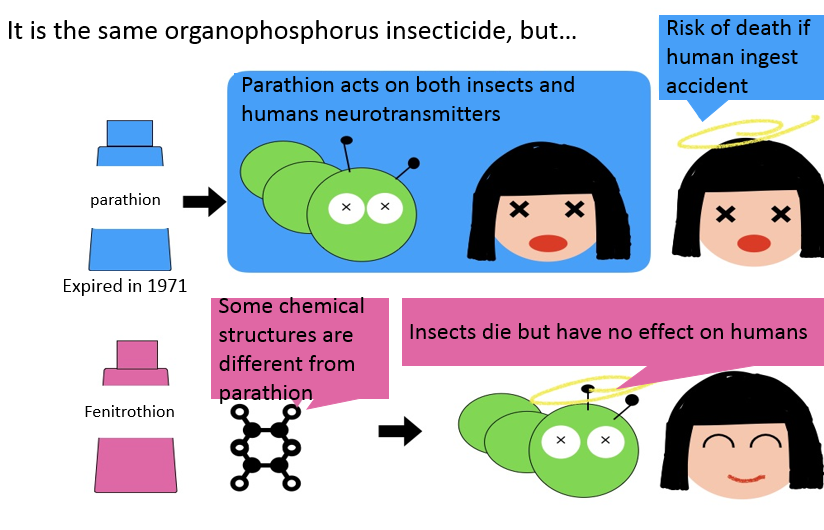Why Were Agrochemicals Developed? : Today’s Agrochemicals
Today’s Agrochemicals 
How have today’s agrochemicals developed?
The Improvement of The Quality of Agrochemicals
At first, let us see the changes in the need for agrochemicals.

Reference AJINOMOTO CO. INC (1996-2020).
Noyaku no yakuwari tte? Anzen nano? [Why are agrochemicals used? Are agrochemicals safe?] [website].
Retrieved from
https://www.ajinomoto.co.jp/products
This graph shows how much an amount of agrochemical per area should be used.
From this graph, we can see that the amount tends to be getting smaller since the 1960s. This is not because agrochemicals have been more powerful, but because the way of using them has been more efficient.
It does not mean they have been more dangerous. One of how agrochemicals are used efficiently is that their effects focus on the target.
The way harms only pests and pathogenic bacteria, not organisms which we do not want them to affect such as humans and livestock animals.
Masako Kamiji, a pre-chairperson of the Association of the Japan Agents, (1996-2020) describes “that they are effective is very different from that they became very strong and harmful. It means that agrochemicals became to affect only the targeting organisms except human and they were becoming more safely.”

Reference Tottori Prefecture. About Optionality of Agrochemicals [pdf].
Retrieved from
] https://www.pref.tottori.lg.jp/secure
Next, let's look at the change in the residual period of agrochemicals in the environment.

Reference AJINOMOTO CO. INC (1996-2020). Noyaku no yakuwari tte? Anzen nano? [Why are agrochemicals used? Are agrochemicals safe?] [website].
Retrieved from
https://www.ajinomoto.co.jp/products
It can be seen that the speed at which agrochemicals are decomposed is quicker than the past. (The table above shows how long it takes for 75%-100% of them to disappear. The table below shows how many days it takes for half of them to disappear. The difference makes it difficult to make a comparison between data in the table above and the table below.)
In other words, agrochemicals remain more hardly in the environment. Today’s agrochemicals are more effective and less harmful.
Considerations for Environmental and Ecosystems
The performance of the agrochemicals are improved.
However, some people think today’s agrochemicals are not different from those in the past, so they destroy the environment and ecosystems indirectly.
We will explain efforts that minimize the bad effects on the environment and ecosystems.
First of all, see the impact on the environment. Many of the scattered
agrochemicals spread in the air, water, and soil.
The agrochemicals in the air are photolyzed. The agrochemicals in the water main in the rivers are photolyzed and decomposed. Agrochemicals in the soil are decomposed.
| where to spread | how to spread |
| the air | The agrochemicals are photolyzed. |
| water | The agrochemicals are photolyzed and decomposed. |
| soil | The agrochemicals are decomposed. |
The standard permits using the agrochemicals if they are photolyzed or decomposed.
(If you want to know more about this, go to the next page.)
Thanks to the standard, the permitted agrochemicals do not affect the environment. Fukuda Toshio, who is a specialist in agriculture (2000), describes that “Though the Environmental Agency investigates the concentration of more than 750 kinds of chemicals including agricultural ingredients in the environment, it is very rare to find agrochemicals.”
Do the agrochemicals harm the ecosystems?
It is difficult to show the evidence if the agrochemicals harm the ecosystems because it is impossible to examine all of the organisms, and certain species are tested in laboratories. ※OECD:Organization for Economic Co-operation and Development Reference Food Safety Commission of Japan. The government sets the standards to minimize the influence on the ecosystems by making various experiments in the above table.
It is difficult to know if the agrochemicals influence the environment and ecosystems, but many efforts and the standard of agrochemicals contributes to safety.
The results tested in the laboratories are different from in the natural environment, and it is difficult to determine their effect on the whole ecosystem. On the other hand, there is a way to test organisms in the natural environment.
The test is difficult to identify the factor of a change of the ecosystem. It is also difficult to compare the results under the same conditions. 
About Environmental Impact by Agrochemicals [pdf].Retrieved from
https://www.fsc.go.jp › fsciis › attachedFile


